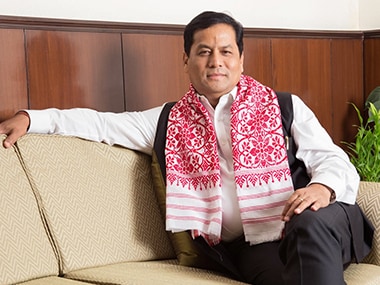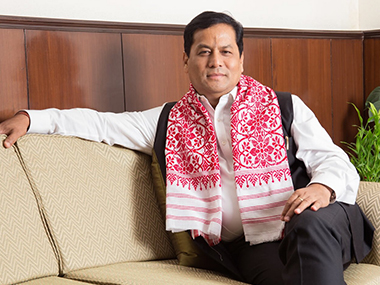Amid growing discontent against the current BJP-AGP government in Assam the cabinet led by Chief Minister Sarbananda Sonowal on 23 December 2019, suggested that the Government of India might amend Article 345 of the Indian Constitution. The new amendment will make Assamese the state language of Assam, excluding BTAD (Bodoland Territorial Administrative Districts), Hill Districts and Barak Valley. The cabinet has further suggested that Assamese will be made a compulsory language in English and other medium schools till class 10, except in BTAD, Hill Districts and Barak Valley. The cabinet proposal targets at fulfilling the demands of the Assamese speaking majority in the Brahmaputra Valley in the wake of rising insecurities among the people after the Citizenship Amendment Bill (CAB) was passed in both Houses of the Parliament earlier this month.[caption id=“attachment_3477046” align=“alignleft” width=“380”]  File image of Assam chief minister Sarbananda Sonowal. Image courtesy @sarbanandsonwal/Twitter[/caption] If amended, Article 345 will allay the fears of a majority who have been fighting for their rights to language and culture in a region that has a long history of people’s movement against ‘foreigners’. The anti-foreigner movement (1979-85) and now the anti-CAA movement led by All Assam Students’ Union (AASU) and All Assam Muslim Student’s Union (AAMSU) converge on this crucial question of language. State finance minister Himanta Biswa Sharma, announcing the decisions taken at the latest state cabinet meeting, said that it will serve “the overall well-being of people, numerous indigenous communities, and the state (…)”. But, which ‘people’ is he referring to? Whose ‘well-being’? and, do the ‘numerous indigenous communities’ all consider Assamese as their language? It is generally argued by scholars from the North East Region (NER) that Assam comprises of two distinct cultural and linguistic zones – Brahmaputra Valley and Barak Valley. While Brahmaputra Valley is believed to be ‘Assamese’, Barak Valley claims a distinct ‘Bengali’ identity of their own. There are further claims to distinct histories of the two valleys that have often been highlighted and sometimes exaggerated, by scholars from the region. The problem, however, lies elsewhere. Not all people in Brahmaputra Valley speak Assamese nor do they consider it as their mother tongue. Certainly, Assamese is the common tongue, a shared language in Brahmaputra Valley and everyday communication often takes place in the language. But, to declare it as the state language and to make it ‘compulsory’ for students in all schools across the valley will certainly lead to a situation where many people who do not speak the language will be forced to learn it. It will effectively mean that in the near future, children across the valley will have to learn Assamese even if they consider Miya, Sadri, Nagamese, Nepali, Bengali and other languages as their mother tongue. Earlier this year, certain public intellectuals from Brahmaputra Valley stirred up a controversy by claiming that Miya, spoken by a large section of Muslims in Brahmaputra Valley, isn’t a language. The cabinet proposal will only bolster such claims and alienate people on the basis of language. Assamese is not the only language spoken in Brahmaputra Valley. It is the language of the majority residing there and is shared across religions. It is spoken by caste Hindus, Muslims and lower-caste groups who constitute the jati referred to as Axomiya or Assamese. We need to understand this crucial distinction. As a language of the majority, Axomiya or Assamese has a tremendous responsibility towards other languages spoken by minority groups. The relationship between these languages cannot be hierarchical. **Click here for Citizenship Amendment Act protests LIVE Updates** In fact, the relationship between any two languages spoken in a region cannot be marked by dominance over another. Such a relationship stifles the fundamental right of the people to express themselves in their language. The history of Assamese as a language is a history of struggle – against Bengali imposed by the British administration in the valley and later Hindi which has made inroads in the last few decades. Even today, when people speak about the language and its past, the narrative core consists of struggle and sacrifice for the ‘mother tongue’. Historically speaking, if Assamese is an ‘oppressed’ language and one that has emerged to its present status through the struggle of the people then why turn a blind eye to people whose languages aren’t recognised and are, therefore ‘minor’ with respect to Assamese? Why impose a structure of linguistic hierarchy in a society where people do not speak only one language? Why make Assam (of course keeping the crucial exclusions in mind) a monolingual state? One of the problems that might be provoked by this discussion can be that of defining the relationship between Assamese and the other languages with clarity. Most Axomiya or Assamese speakers believe that the language belongs to Aai Axom or Mother Assam. If Assamese is indeed a feminine figure of worship and beauty can one not think of other languages like Nagamese, Sadri, Bodo, Miya, Goalpariya as its sisters and not children? Can one not recognise the beauty that lies in these various languages and allow them to flourish? The ‘well-being’ of a people cannot be served unless we let them express as they want to. And, one of the important spheres of expression is literature. The cabinet proposal for a state language will have adverse effects on the other ‘minor’ languages in the sphere of literature. Most of the ‘minor’ groups have literary societies who find it difficult to secure funds for publishing in their languages. Seeking funds from the state government will become doubly difficult in a future that stands with the promise of a mono-lingual Assam. The cultural condition of Brahmaputra Valley should not be founded on an imposed oneness. It should rather be sought in the syncretic cohabitation of the people while protecting difference and distinctiveness. The valley needs more literary voices – in Nagamese, Bodo, Sadri, Miya and other languages. Those voices should not be curbed in the name of ‘over-all well-being of people’. And, unless the ‘minor’ languages and their speakers are thought of while preparing a road map for the people this cannot never be achieved. Axom Sahitya Sabha (ASS) have historically played a crucial role in fomenting such hierarchy of language in the region. One of the instances of such an assertion can be seen in its reaction to Assamese language being discontinued in Arunachal Pradesh as a medium of instruction. Hem Baruah, who also served as a member of the Parliament, in a speech demanded that the Assamese language to be re-introduced in NEFA, now Arunachal Pradesh, and claimed that Assamese is a ‘natural’ language used for inter-tribal communication. In a memorandum submitted to Syed Fazl Ali, governor of Assam and then Union home minister Pandit GB Pant in 1957 to which Baruah was also a signatory, one of the demands was to make Assamese a ‘compulsory’ second language where a tribal tongue is used a first language. Additionally, the memorandum signed by Nalinibala Debi, Satyendranath Sarma, Harendranath Barua, Atul Chandra Hazarika, Maheswar Neog, Benudhar Sarma, Parag Chaliha and Jatindranath Goswami on behalf of ASS went on to strongly suggest to re-consider Assamese as a primary medium of instruction. Baruah himself in the speech quotes Mahatma Gandhi’s book titled ‘Our Language Problem’ where Gandhi stressed the importance of the mother tongue of a child. In fact, it is through the mother tongue that one is introduced to the primary ethical, moral and emotional worlds. One is born into a linguistic world and it is through the mother-tongue one enters into the ‘human world of a community’. Making Assamese as a ‘compulsory’ language, which establishes a hierarchy of language, destroys the diversity of our society. Renowned academic from Assam, Mrinal Miri rightly notes that linguistic diversity is the essence of human diversity and it is the most ‘magical’ aspect of humanity. This fact is doubly true for North East India. Being in North East we are often born into a multilingual world and our vision hence becomes multi-visionary. These visions are given by the different languages we speak, converse and consume. We don’t hierarchise these visions given to us by language. Each moment of conversation in a particular language is a moment of sharing time with others or with ourselves. The elaborate plan to impose this hierarchy will destroy these multiple visions of seeing and understanding and in turn, deny the ‘magical’ and ‘beautiful’ worlds that different languages take us to. The need of the hour is not a forced homogeneity but an effort towards envisioning a more capacious and inclusive Assamese identity. Language is that point of departure towards inclusivity. Samyak Ghosh studies Literature and History at Columbia University in New York. Suraj is a PhD candidate in Sociology at the National University of Singapore.
The cabinet proposal for a state language will have adverse effects on the other minor languages in the sphere of literature.
Advertisement
End of Article


)

)
)
)
)
)
)
)
)



